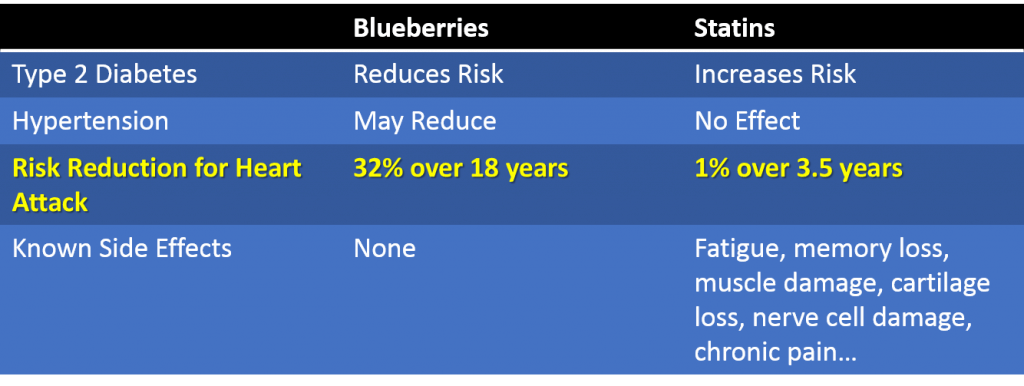Blueberries or Statins to Reduce Heart Attack Risk? Your Call…

An important paper came out this week on how eating blueberries reduces heart risk. Yes, you heard that right, blueberries. In fact it’s fruits that contain Anthocyanin, which include lots of berries, cherries, and grapes. I just read the full paper and produced the chart you see above. First, a caution. The blueberry data is from looking at the Framingham research data so it’s not information collected by testing blueberries in a population and looking at the number of heart attacks, it was collected after the fact by meticulously monitoring a large population of women. The data above for statins was collected by giving statin cholesterol drugs versus placebo and monitoring heart attacks.
From the table above, it’s clear that this likely isn’t even a fair fight. Eating blueberries in research by the same authors have also been associated with reduced type 2 diabetes risk and reduced blood pressure (less hypertension). In reviewing the chart above, you might be wondering why I didn’t quote the number thrown around by Pfizer for how much the cholesterol miracle cure Lipitor reduces heart attack risk (36%). This is because it’s not a 36% reduction in heart attack risk, but “relative risk”. You get to 36% only after a little creative math quoting that the difference between the percentage of heart attacks in the Lipitor versus the placebo group (2% versus 3%). Businessweek had an excellent article exposing cholesterol drugs in 2008. I’ve already blogged extensively about the side effects of statins, which include fatigue, memory loss, muscle damage, cartilage loss, nerve cell damage, and chronic pain. The upshot? Yikes! Eat your blueberries!

NOTE: This blog post provides general information to help the reader better understand regenerative medicine, musculoskeletal health, and related subjects. All content provided in this blog, website, or any linked materials, including text, graphics, images, patient profiles, outcomes, and information, are not intended and should not be considered or used as a substitute for medical advice, diagnosis, or treatment. Please always consult with a professional and certified healthcare provider to discuss if a treatment is right for you.
